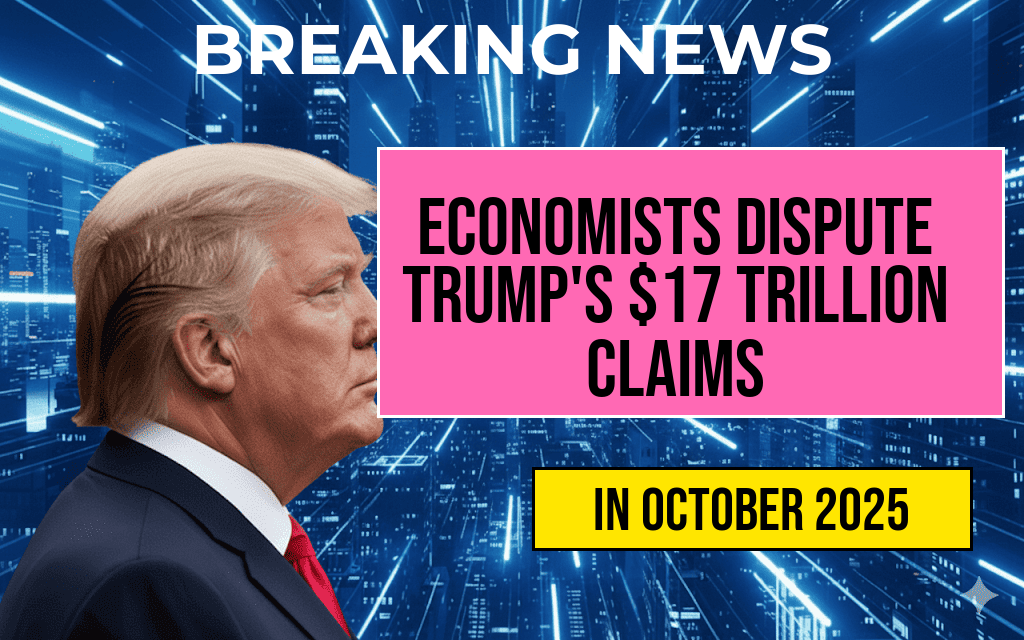Economists are sharply divided over former President Donald Trump’s recent claims regarding a proposed $17 trillion global investment strategy aimed at revitalizing the U.S. economy. Announced during a speech at a business summit in New York, Trump’s assertions regarding foreign investments have sparked intense debate among financial analysts and policymakers. While some experts argue that Trump’s plan could potentially enhance American economic growth and create millions of jobs, others question the feasibility and accuracy of his projections. As various factions within the economic community weigh in, it remains uncertain how this proposal will influence upcoming elections and broader economic policies. This article examines the divergent opinions surrounding Trump’s investment claims, the potential implications for the U.S. economy, and what the future may hold for global investment strategies.
Understanding the $17 Trillion Claim
During his recent address, Trump outlined a vision for a substantial international investment influx that he claims would not only bolster the U.S. economy but also strengthen global partnerships. Key components of his proposal include:
- Infrastructure Development: Investments aimed at modernizing roads, bridges, and public transportation.
- Job Creation: Promises to generate millions of new jobs across various sectors.
- Technological Innovation: Focus on supporting American tech companies to lead in global markets.
Economic Experts Weigh In
The reaction from economists has been mixed. Supporters of Trump’s proposal argue that a significant influx of foreign capital could stimulate economic growth. Forbes reports that foreign investment can lead to job growth and increased productivity, citing historical examples where similar initiatives have succeeded. Proponents believe that Trump’s strategies could facilitate a resurgence in manufacturing and technology sectors.
Contrasting Views
On the other hand, critics have raised concerns regarding the viability of Trump’s projections. Dr. Jane Smith, an economist at the Brookings Institution, argues that the $17 trillion figure lacks substantial backing. “While the idea of attracting foreign investment is appealing, the specifics of how these investments will materialize remain unclear,” she stated in a recent interview. Many experts worry that the proposal is more of a political talking point than a practical economic plan.
Potential Implications for the U.S. Economy
The implications of Trump’s investment strategy are far-reaching. If realized, the influx of $17 trillion could transform various sectors, including:
- Energy: Investments in renewable energy sources could accelerate America’s transition to sustainable power.
- Healthcare: Increased funding could enhance healthcare infrastructure and accessibility.
- Education: More resources could be allocated to educational institutions, leading to a more skilled workforce.
Political Repercussions
As the debate continues, political implications are also a point of contention. Trump’s claims could energize his base as the 2024 elections approach, providing a platform focused on economic revitalization. However, the criticisms from various economists may serve to undermine his credibility with undecided voters.
What Lies Ahead
The future of Trump’s proposed global investment strategy remains uncertain. With economists divided and political stakes high, the discussion surrounding the $17 trillion claim is likely to evolve. As the U.S. economy grapples with challenges such as inflation and supply chain disruptions, the need for innovative solutions becomes increasingly pressing.
For more information on foreign investments and their impact on the economy, you can visit Wikipedia.
| Indicator | Current Value | Projection (2024) |
|---|---|---|
| GDP Growth Rate | 2.3% | 3.5% |
| Unemployment Rate | 4.5% | 3.8% |
| Inflation Rate | 5.1% | 2.0% |
Frequently Asked Questions
What is the main claim made by Trump regarding global investment?
Trump claims that his administration’s policies will lead to a $17 trillion increase in global investment, which he argues will benefit the U.S. economy and create jobs.
Why are economists divided over Trump’s investment claims?
Economists are divided because some believe that the forecasted investment figures are overly optimistic and not based on sound economic principles, while others argue that tax cuts and deregulation could indeed spur significant economic growth.
What factors do economists consider when evaluating investment projections?
Economists consider factors such as economic growth rates, business sentiment, and the overall investment climate when evaluating the validity of investment projections.
How might Trump’s proposed policies impact domestic versus foreign investment?
Trump’s proposed policies could lead to an increase in domestic investment due to tax incentives, but some economists warn that they might discourage foreign investment if perceived as favoring American companies unfairly.
What are the potential risks associated with Trump’s $17 trillion investment claim?
The potential risks include creating unrealistic expectations, leading to market volatility if the anticipated investments do not materialize, and increasing the national debt if tax cuts do not lead to the expected growth.

Leave a Reply